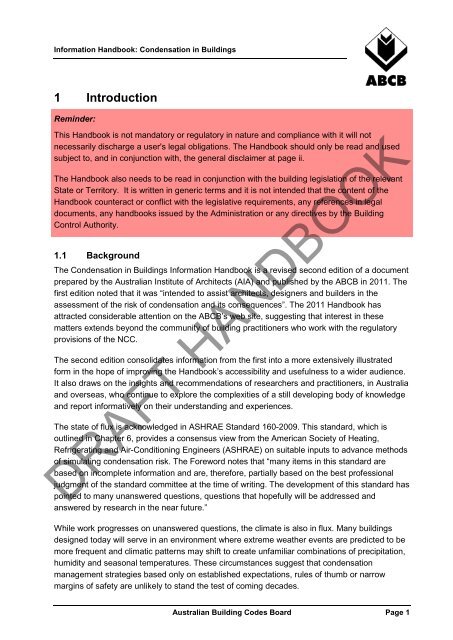Condensation in Buildings - Australian Building Codes Board
Condensation in Buildings - Australian Building Codes Board
Condensation in Buildings - Australian Building Codes Board
Create successful ePaper yourself
Turn your PDF publications into a flip-book with our unique Google optimized e-Paper software.
Information Handbook: <strong>Condensation</strong> <strong>in</strong> Build<strong>in</strong>gs<br />
1 Introduction<br />
Rem<strong>in</strong>der:<br />
This Handbook is not mandatory or regulatory <strong>in</strong> nature and compliance with it will not<br />
necessarily discharge a user's legal obligations. The Handbook should only be read and used<br />
subject to, and <strong>in</strong> conjunction with, the general disclaimer at page ii.<br />
The Handbook also needs to be read <strong>in</strong> conjunction with the build<strong>in</strong>g legislation of the relevant<br />
State or Territory. It is written <strong>in</strong> generic terms and it is not <strong>in</strong>tended that the content of the<br />
Handbook counteract or conflict with the legislative requirements, any references <strong>in</strong> legal<br />
documents, any handbooks issued by the Adm<strong>in</strong>istration or any directives by the Build<strong>in</strong>g<br />
Control Authority.<br />
1.1 Background<br />
The <strong>Condensation</strong> <strong>in</strong> Build<strong>in</strong>gs Information Handbook is a revised second edition of a document<br />
prepared by the <strong>Australian</strong> Institute of Architects (AIA) and published by the ABCB <strong>in</strong> 2011. The<br />
first edition noted that it was “<strong>in</strong>tended to assist architects, designers and builders <strong>in</strong> the<br />
assessment of the risk of condensation and its consequences”. The 2011 Handbook has<br />
attracted considerable attention on the ABCB’s web site, suggest<strong>in</strong>g that <strong>in</strong>terest <strong>in</strong> these<br />
matters extends beyond the community of build<strong>in</strong>g practitioners who work with the regulatory<br />
provisions of the NCC.<br />
The second edition consolidates <strong>in</strong>formation from the first <strong>in</strong>to a more extensively illustrated<br />
form <strong>in</strong> the hope of improv<strong>in</strong>g the Handbook’s accessibility and usefulness to a wider audience.<br />
It also draws on the <strong>in</strong>sights and recommendations of researchers and practitioners, <strong>in</strong> Australia<br />
and overseas, who cont<strong>in</strong>ue to explore the complexities of a still develop<strong>in</strong>g body of knowledge<br />
and report <strong>in</strong>formatively on their understand<strong>in</strong>g and experiences.<br />
The state of flux is acknowledged <strong>in</strong> ASHRAE Standard 160-2009. This standard, which is<br />
outl<strong>in</strong>ed <strong>in</strong> Chapter 6, provides a consensus view from the American Society of Heat<strong>in</strong>g,<br />
Refrigerat<strong>in</strong>g and Air-Condition<strong>in</strong>g Eng<strong>in</strong>eers (ASHRAE) on suitable <strong>in</strong>puts to advance methods<br />
of simulat<strong>in</strong>g condensation risk. The Foreword notes that “many items <strong>in</strong> this standard are<br />
based on <strong>in</strong>complete <strong>in</strong>formation and are, therefore, partially based on the best professional<br />
judgment of the standard committee at the time of writ<strong>in</strong>g. The development of this standard has<br />
po<strong>in</strong>ted to many unanswered questions, questions that hopefully will be addressed and<br />
answered by research <strong>in</strong> the near future.”<br />
DRAFT HANDBOOK<br />
While work progresses on unanswered questions, the climate is also <strong>in</strong> flux. Many build<strong>in</strong>gs<br />
designed today will serve <strong>in</strong> an environment where extreme weather events are predicted to be<br />
more frequent and climatic patterns may shift to create unfamiliar comb<strong>in</strong>ations of precipitation,<br />
humidity and seasonal temperatures. These circumstances suggest that condensation<br />
management strategies based only on established expectations, rules of thumb or narrow<br />
marg<strong>in</strong>s of safety are unlikely to stand the test of com<strong>in</strong>g decades.<br />
<strong>Australian</strong> Build<strong>in</strong>g <strong>Codes</strong> <strong>Board</strong> Page 1
















